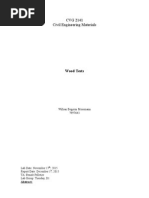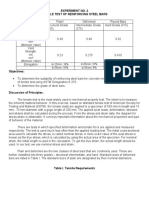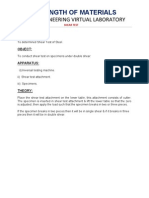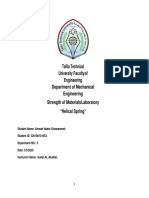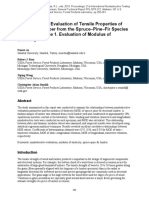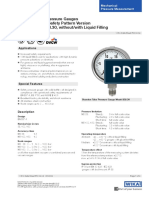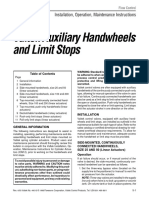Lab 6 - Compression Testing of Wood
Uploaded by
Manikandan SelvamLab 6 - Compression Testing of Wood
Uploaded by
Manikandan SelvamLAB 6
COMPRESSION TESTING OF WOOD
The goal of this lab is to help provide better understanding of the properties of
wood. Four samples will be tested; two for compressive strength with the load
parallel to the grains and two with the load perpendicular to the grains. This will
enable the calculations of the modulus of elasticity and the maximum strength
under compression for both loading parallel and perpendicular to the grain. The
influence of grain direction and wood type, as well as failure mechanism can be
identified.
1.0 Introduction
Introduce the subject in the report and state briefly the purpose and usefulness of
the study.
Briefly introduce the type of wood (i.e. Oak is a kind of hard wood, pine is a kind
of soft wood), the type of tests
2.0 Testing Procedure
2.1
Details of the samples
Briefly introduce the type of wood (i.e. Oak is a kind of hard wood, pine is a kind
of soft wood).
Mention briefly what differences can be seen between the
properties of the hard and soft woods (density, surface hardness, etc.).
2.2
Specimen geometry
Table 1: Specimen Dimensions
Wood
Name
Test Type
Thickness
(mm)
Width
(mm)
Length
(mm)
Compression
Parallel to
Grain
Oak
Compression
Perpendicular
to Grain
Pine
Compression
Parallel to
Grain
Compression
Perpendicular
to Grain
2.3
Detail of testing equipment
Briefly describe the testing equipment & procedure. Photographs or a schematic
of the test equipment may aid your description.
3.0 Measured data
Describe what constitutes failure for wood under compressive testing. What is
the nature of the failure?
Mention briefly what differences can be seen between the mechanical properties
of the hard and soft woods.
Table 2: Failure Loads
Wood
Name
Test Type
Failure
Load (kN)
Compression
Parallel to
Grains
Oak
Compression
Perpendicular
to Grains
Pine
Compression
Parallel to
Grains
Compression
Perpendicular
to Grains
4.0 Discussion
Strength is the defined as:
max =
P
A
(Equation 1)
Where P is the peak load and A is the cross sectional area of the block.
Strain is defined as:
c =
L
L
(Equation 2)
Were L is the change in length of the specimen and L is the length (or height).
4.1
Variability of Material
Plot the a histogram of compressive strength for all the four loading cases.
Discuss the variability in the mechanical strength of wood. The tested samples
were clear timber. What would happen to the variability if defects such as knots
were included? How do Civil engineers deal with this variability?
Table 3 describes the variability in strength of the wood.
Table 3: Variability in Wood
Wood
Oak
Pine
4.2
Test
Average
Strength
Standard
Deviation
Compression
Parallel to
Grains
Compression
Perpendicular
to Grains
Compression
Parallel to
Grains
Compression
Perpendicular
to Grains
Stress vs. Strain
Individual engineering stress-strain curves are required for each specimen. In
addition one stress strain plot off all the samples is required to clearly show the
difference between their mechanical properties. Discuss any significant points /
behaviour observed in the loading of the samples.
4.3
Mechanical properties
Describe the calculation of mechanical properties (For more details refer to
mechanical properties section of Tensile Testing of Metals Lab)
Table 4: Mechanical Properties
Wood
Name
Test Type
Specimen
No.
Compression
Parallel to
Grains
Oak 1
Compression
Perpendicular
to Grains
Oak 2
Compression
Parallel to
Grains
Pine 1
Compression
Perpendicular
to Grains
Pine 2
Strength
(MPa)
Failure
E (GPa)
Oak
Pine
4.4
Description of Specimen Failure
Include a sketch or picture that shows the observed failure in the lab. Why type
of failures were witnessed? Describe the mechanics of the failures, highlighting
the differences between the parallel and perpendicular tests.
4.5
Sources of Error
Define the sources of Error this testing procedure
5.0 Concluding Remarks
Summarize the findings. Note that the conclusions should satisfy each objective,
stated or implicit, in the Introduction. There must not be any new material.
6.0 References
Document the references considered in preparing the report.
Be sure to include sample calculations
You might also like
- Parts Manual RT12-RT24 053-2438 Issue 8No ratings yetParts Manual RT12-RT24 053-2438 Issue 8167 pages
- Relative Density and Water Absorption of Aggregates Lab Report50% (4)Relative Density and Water Absorption of Aggregates Lab Report4 pages
- Torsion of Rods (Laboratory Practical) 2016100% (1)Torsion of Rods (Laboratory Practical) 20166 pages
- Experiment No.1 Specific Gravity and Absorption of Coarse Aggregate50% (10)Experiment No.1 Specific Gravity and Absorption of Coarse Aggregate2 pages
- Compression Test em 327: Mechanics of Materials Laboratory: Objectives88% (8)Compression Test em 327: Mechanics of Materials Laboratory: Objectives5 pages
- Me136p Exp2 Tensile Test of Reinforcing Steel BarsNo ratings yetMe136p Exp2 Tensile Test of Reinforcing Steel Bars15 pages
- Familiarization With The Apparatus and Equipment Used in Materials TestingNo ratings yetFamiliarization With The Apparatus and Equipment Used in Materials Testing72 pages
- Testing of Wood: Samples For Bending, Compression, Shear, Tension, and Water Content WoodNo ratings yetTesting of Wood: Samples For Bending, Compression, Shear, Tension, and Water Content Wood4 pages
- CE405 - Experiment 3 - Determination of Specific Gravity and Water Absorption of AggregatesNo ratings yetCE405 - Experiment 3 - Determination of Specific Gravity and Water Absorption of Aggregates5 pages
- Advantages of Steel As A Structural MaterialNo ratings yetAdvantages of Steel As A Structural Material3 pages
- LabEx No. 4 Tensile Test of Reinforcing BarNo ratings yetLabEx No. 4 Tensile Test of Reinforcing Bar4 pages
- Specific Gravity and Absorption of Coarse Aggregate (Astm C127) Testing ObjectivesNo ratings yetSpecific Gravity and Absorption of Coarse Aggregate (Astm C127) Testing Objectives4 pages
- Me136p Exp5 Sieve Analysis of AggregatesNo ratings yetMe136p Exp5 Sieve Analysis of Aggregates9 pages
- This Study Resource Was: Laboratory Exercise 2 Preparation of Disturbed Soil Sample For Test ObjectiveNo ratings yetThis Study Resource Was: Laboratory Exercise 2 Preparation of Disturbed Soil Sample For Test Objective3 pages
- Experiment No.: 5 Test of Slender Column: 1. ObjectivesNo ratings yetExperiment No.: 5 Test of Slender Column: 1. Objectives6 pages
- Module 1 - Stresses-Normal Stress, Shear Stress and Bearing StressNo ratings yetModule 1 - Stresses-Normal Stress, Shear Stress and Bearing Stress24 pages
- Determination of Setting Time of Hydraulic Cement: Standard Test MethodsNo ratings yetDetermination of Setting Time of Hydraulic Cement: Standard Test Methods4 pages
- To Perform Torsion Test On Mild Steel and Cast Iron PDF100% (3)To Perform Torsion Test On Mild Steel and Cast Iron PDF10 pages
- Experiment No. 3: Sieve Analysis of Coarse and Fine Aggregate DiscussionNo ratings yetExperiment No. 3: Sieve Analysis of Coarse and Fine Aggregate Discussion22 pages
- Laboratory No. 11 Laboratory Concrete Mix ProportioningNo ratings yetLaboratory No. 11 Laboratory Concrete Mix Proportioning7 pages
- CONSTRUCTION MATERIALS AND TESTING1 SEC LectureNo ratings yetCONSTRUCTION MATERIALS AND TESTING1 SEC Lecture64 pages
- Nondestructive Evaluation of Tensile Properties of Structural Lumber From The Spruce-Pine-Fir Species Grouping - Phase 1 Evaluation of Modulus of ElasticityNo ratings yetNondestructive Evaluation of Tensile Properties of Structural Lumber From The Spruce-Pine-Fir Species Grouping - Phase 1 Evaluation of Modulus of Elasticity12 pages
- Akt Memorial College of Engineering and Technology B.E, Model Exam, October-2017 Fifth Semester, (Regulation 2013) Ce 6503 - Environmental Engineering-INo ratings yetAkt Memorial College of Engineering and Technology B.E, Model Exam, October-2017 Fifth Semester, (Regulation 2013) Ce 6503 - Environmental Engineering-I2 pages
- MA6351-Transforms and Partial Differential EquationNo ratings yetMA6351-Transforms and Partial Differential Equation15 pages
- Unit - I: Subject Name: Design of RC ElementsNo ratings yetUnit - I: Subject Name: Design of RC Elements10 pages
- Akt Memorial College of Engineering and TechnologyNo ratings yetAkt Memorial College of Engineering and Technology1 page
- Reg. No: Akt Memorial College of Engineering and Technology: PART A - (5 X 2 10 Marks)No ratings yetReg. No: Akt Memorial College of Engineering and Technology: PART A - (5 X 2 10 Marks)1 page
- AIRCEL E-Payment Receipt:: Drdapuos Chitra A: Bill Payment: 8883241777: TN0414095000No ratings yetAIRCEL E-Payment Receipt:: Drdapuos Chitra A: Bill Payment: 8883241777: TN04140950001 page
- FMDS 03 10 - Installation & Maintenance of Fire Service Mains100% (1)FMDS 03 10 - Installation & Maintenance of Fire Service Mains59 pages
- Autogiro Ela, Maintenance Manual m07 03 Issue 2 Sep 2009.No ratings yetAutogiro Ela, Maintenance Manual m07 03 Issue 2 Sep 2009.21 pages
- The Danger of Burning Plastic: Why Are Cancer Rates So High?No ratings yetThe Danger of Burning Plastic: Why Are Cancer Rates So High?8 pages
- Valtek Handwheels and Limit Stops (Flow Serve)No ratings yetValtek Handwheels and Limit Stops (Flow Serve)12 pages
- The Dynamic Principles of Machine Foundations and GroundNo ratings yetThe Dynamic Principles of Machine Foundations and Ground22 pages
- No of List Use Construction Tools and Pieces of EquipmentNo ratings yetNo of List Use Construction Tools and Pieces of Equipment20 pages
- The AK 47 Kalashnikov series assault rifles Weapon Rottman - Download the full set of chapters carefully compiled100% (2)The AK 47 Kalashnikov series assault rifles Weapon Rottman - Download the full set of chapters carefully compiled47 pages
- ITC571 - Emerging Technologies and Innovation: Subject CoordinatorNo ratings yetITC571 - Emerging Technologies and Innovation: Subject Coordinator17 pages
- SDS1022 / SDS1102 Digital Storage Oscilloscope User ManualNo ratings yetSDS1022 / SDS1102 Digital Storage Oscilloscope User Manual66 pages
- Relative Density and Water Absorption of Aggregates Lab ReportRelative Density and Water Absorption of Aggregates Lab Report
- Experiment No.1 Specific Gravity and Absorption of Coarse AggregateExperiment No.1 Specific Gravity and Absorption of Coarse Aggregate
- Compression Test em 327: Mechanics of Materials Laboratory: ObjectivesCompression Test em 327: Mechanics of Materials Laboratory: Objectives
- Me136p Exp2 Tensile Test of Reinforcing Steel BarsMe136p Exp2 Tensile Test of Reinforcing Steel Bars
- Familiarization With The Apparatus and Equipment Used in Materials TestingFamiliarization With The Apparatus and Equipment Used in Materials Testing
- Testing of Wood: Samples For Bending, Compression, Shear, Tension, and Water Content WoodTesting of Wood: Samples For Bending, Compression, Shear, Tension, and Water Content Wood
- CE405 - Experiment 3 - Determination of Specific Gravity and Water Absorption of AggregatesCE405 - Experiment 3 - Determination of Specific Gravity and Water Absorption of Aggregates
- Specific Gravity and Absorption of Coarse Aggregate (Astm C127) Testing ObjectivesSpecific Gravity and Absorption of Coarse Aggregate (Astm C127) Testing Objectives
- This Study Resource Was: Laboratory Exercise 2 Preparation of Disturbed Soil Sample For Test ObjectiveThis Study Resource Was: Laboratory Exercise 2 Preparation of Disturbed Soil Sample For Test Objective
- Experiment No.: 5 Test of Slender Column: 1. ObjectivesExperiment No.: 5 Test of Slender Column: 1. Objectives
- Module 1 - Stresses-Normal Stress, Shear Stress and Bearing StressModule 1 - Stresses-Normal Stress, Shear Stress and Bearing Stress
- Determination of Setting Time of Hydraulic Cement: Standard Test MethodsDetermination of Setting Time of Hydraulic Cement: Standard Test Methods
- To Perform Torsion Test On Mild Steel and Cast Iron PDFTo Perform Torsion Test On Mild Steel and Cast Iron PDF
- Experiment No. 3: Sieve Analysis of Coarse and Fine Aggregate DiscussionExperiment No. 3: Sieve Analysis of Coarse and Fine Aggregate Discussion
- Laboratory No. 11 Laboratory Concrete Mix ProportioningLaboratory No. 11 Laboratory Concrete Mix Proportioning
- Nondestructive Evaluation of Tensile Properties of Structural Lumber From The Spruce-Pine-Fir Species Grouping - Phase 1 Evaluation of Modulus of ElasticityNondestructive Evaluation of Tensile Properties of Structural Lumber From The Spruce-Pine-Fir Species Grouping - Phase 1 Evaluation of Modulus of Elasticity
- Akt Memorial College of Engineering and Technology B.E, Model Exam, October-2017 Fifth Semester, (Regulation 2013) Ce 6503 - Environmental Engineering-IAkt Memorial College of Engineering and Technology B.E, Model Exam, October-2017 Fifth Semester, (Regulation 2013) Ce 6503 - Environmental Engineering-I
- MA6351-Transforms and Partial Differential EquationMA6351-Transforms and Partial Differential Equation
- Akt Memorial College of Engineering and TechnologyAkt Memorial College of Engineering and Technology
- Reg. No: Akt Memorial College of Engineering and Technology: PART A - (5 X 2 10 Marks)Reg. No: Akt Memorial College of Engineering and Technology: PART A - (5 X 2 10 Marks)
- AIRCEL E-Payment Receipt:: Drdapuos Chitra A: Bill Payment: 8883241777: TN0414095000AIRCEL E-Payment Receipt:: Drdapuos Chitra A: Bill Payment: 8883241777: TN0414095000
- FMDS 03 10 - Installation & Maintenance of Fire Service MainsFMDS 03 10 - Installation & Maintenance of Fire Service Mains
- Autogiro Ela, Maintenance Manual m07 03 Issue 2 Sep 2009.Autogiro Ela, Maintenance Manual m07 03 Issue 2 Sep 2009.
- The Danger of Burning Plastic: Why Are Cancer Rates So High?The Danger of Burning Plastic: Why Are Cancer Rates So High?
- The Dynamic Principles of Machine Foundations and GroundThe Dynamic Principles of Machine Foundations and Ground
- No of List Use Construction Tools and Pieces of EquipmentNo of List Use Construction Tools and Pieces of Equipment
- The AK 47 Kalashnikov series assault rifles Weapon Rottman - Download the full set of chapters carefully compiledThe AK 47 Kalashnikov series assault rifles Weapon Rottman - Download the full set of chapters carefully compiled
- ITC571 - Emerging Technologies and Innovation: Subject CoordinatorITC571 - Emerging Technologies and Innovation: Subject Coordinator
- SDS1022 / SDS1102 Digital Storage Oscilloscope User ManualSDS1022 / SDS1102 Digital Storage Oscilloscope User Manual


